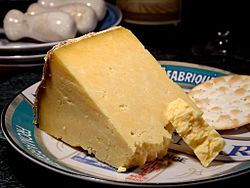Cheshire cheese facts for kids
Quick facts for kids Cheshire |
|
|---|---|
 |
|
| Country of origin | England |
| Region, town | Cheshire |
| Source of milk | Cows |
| Pasteurised | Frequently |
| Texture | hard crumbly |
| Aging time | 4-8 weeks depending on variety |
| Certification | No |
Cheshire cheese is a popular type of cheese from England. It's known for being dense and crumbly. This cheese is mostly made in the county of Cheshire. It's also made in nearby areas like Denbighshire and Flintshire in Wales. Plus, it's produced in Shropshire and Staffordshire in England.
Contents
The Story of Cheshire Cheese
Cheshire cheese has a very long history. It is one of the oldest cheeses in Britain that we know by name. The first time it was written about was around 1580. A writer named Thomas Muffet mentioned it in his book Health's Improvement. Some people think it's even older, but that's not true.
Cheshire Cheese: A Favorite for Centuries
Cheshire cheese was super popular in the late 1700s. In fact, in 1758, the Royal Navy ordered it for their ships. They wanted their sailors to have Cheshire and Gloucester cheeses.
By 1823, people were making a lot of Cheshire cheese. About 10,000 tonnes were made each year. By 1870, this number grew to about 12,000 tonnes annually.
How Cheese Travel Changed Over Time
For a long time, Cheshire cheeses were made very hard. This was so they could survive long trips to London. They traveled by horse and cart, and later by boat.
But later, a new type of Cheshire cheese became popular. This was a younger, fresher, and more crumbly cheese. It was similar to the Cheshire cheese we eat today. This newer cheese was cheaper to make. It didn't need to be stored for as long. It became very popular in the industrial areas of the North and Midlands.
Cheshire Cheese Today
Sales of Cheshire cheese reached their highest point in 1960. About 40,000 tonnes were sold that year. After that, people started buying many other kinds of cheeses. So, sales of Cheshire cheese went down.
Even today, Cheshire cheese is still very important. It is the UK's best-selling crumbly cheese. About 6,000 tonnes are sold every year. The county of Cheshire is still a big center for cheese making. It even hosts the Nantwich International Cheese Awards.
What Does Cheshire Cheese Look Like?
Cheshire cheese is dense and semi-hard. It is known for being moist and crumbly. It also has a mild, salty taste. Some versions made in factories are drier. They are less crumbly, more like a mild Cheddar cheese. This makes them easier to process.
Cheshire cheese belongs to a special group of crumbly cheeses. Other cheeses in this group come from the North of England. These include Wensleydale and Crumbly Lancashire.
Different Kinds of Cheshire Cheese
Cheshire cheese comes in three main types: red, white, and blue. Most of the cheese made is the original plain white version.
Red Cheshire Cheese
Red Cheshire cheese is colored with something called annatto. This gives it a deep orange color. This type of cheese was first made in the hills of North Wales. It was sold to people traveling to Holyhead.
This orange cheese became so popular that travelers thought all Cheshire cheese was orange. So, cheese makers in Cheshire started to dye their cheese too. They wanted to meet what people expected.
Blue Cheshire Cheese
Blue Cheshire cheese has blue veins, just like Stilton or Shropshire Blue. However, it is not as creamy as Stilton. Also, it is not colored orange like Shropshire Blue.
Historically, this blue cheese was very popular in London clubs. People enjoyed it a lot during the Georgian period. Production of blue Cheshire stopped in the late 1980s. But recently, some cheese makers in England have started making it again!
See also
 In Spanish: Cheshire (queso) para niños
In Spanish: Cheshire (queso) para niños

